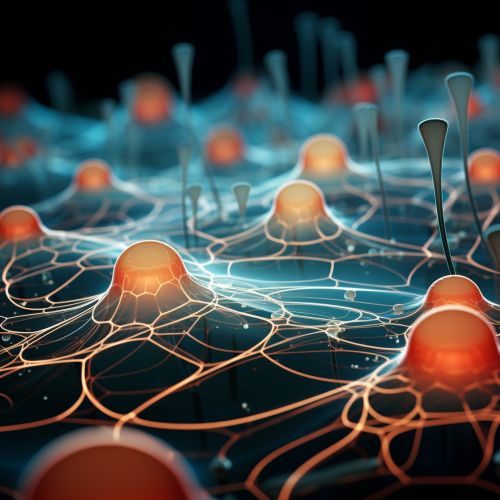Haptotaxis
Introduction
Haptotaxis, derived from the Greek words 'haptein' meaning to fasten, and 'taxis' meaning arrangement, is a biological phenomenon where the directional movement of cells or organisms is influenced by the gradient of a substrate-bound molecule chemotactic agent. This phenomenon is crucial in various biological processes, including wound healing, embryogenesis, and cancer metastasis.
Biological Significance
Haptotaxis plays a significant role in numerous biological processes. For instance, during embryonic development, cells move to specific locations to form different tissues and organs. This movement is guided by haptotaxis, where cells respond to gradients of substrate-bound molecules.
In wound healing, haptotaxis is critical for the migration of fibroblasts to the wound site. The fibroblasts, which produce collagen and other extracellular matrix proteins, move towards higher concentrations of these molecules, effectively closing the wound and promoting tissue repair.


Haptotaxis also plays a role in the metastasis of cancer. Cancer cells can utilize haptotaxis to move towards blood vessels, where they can then enter the bloodstream and spread to other parts of the body. This process, known as cancer metastasis, is a major factor in the severity and mortality of cancer.
Mechanism of Haptotaxis
The mechanism of haptotaxis involves the interaction of cells with their surrounding environment. Cells possess receptors on their surface that can bind to substrate-bound molecules. When these receptors bind to their corresponding molecules, they trigger a series of intracellular events that lead to changes in cell shape and movement.
The gradient of substrate-bound molecules is key to the direction of cell movement. Cells move towards areas of higher concentration of these molecules, a process driven by the reorganization of the cell's cytoskeleton. This reorganization involves the polymerization and depolymerization of cytoskeletal proteins, such as actin and tubulin, which generate the forces necessary for cell movement.
Haptotaxis vs. Chemotaxis
While both haptotaxis and chemotaxis involve the movement of cells in response to a gradient, they differ in the nature of the gradient. In chemotaxis, the gradient is formed by soluble molecules that can diffuse through the environment. In contrast, haptotaxis involves a gradient of substrate-bound molecules that are immobilized on a surface.
Another difference lies in the receptors involved. Chemotaxis involves receptors that can bind to soluble molecules, while haptotaxis involves receptors that can bind to substrate-bound molecules. Despite these differences, both processes are crucial for cell migration and play key roles in various biological processes.
Research and Applications
Research into haptotaxis has potential applications in various fields, including tissue engineering, drug delivery, and cancer treatment. For instance, understanding the mechanisms of haptotaxis can aid in the design of scaffolds for tissue engineering. These scaffolds can be designed to have gradients of substrate-bound molecules, guiding the migration of cells and promoting tissue regeneration.
In drug delivery, haptotaxis can be utilized to guide drug-loaded particles to specific locations in the body. By coating these particles with molecules that can bind to cell receptors, they can be directed towards areas of higher concentration of these molecules, effectively delivering the drug to the target site.
In cancer treatment, understanding haptotaxis can aid in the development of therapies that inhibit cancer metastasis. By blocking the receptors involved in haptotaxis, the movement of cancer cells towards blood vessels can be prevented, potentially reducing the spread of cancer.
